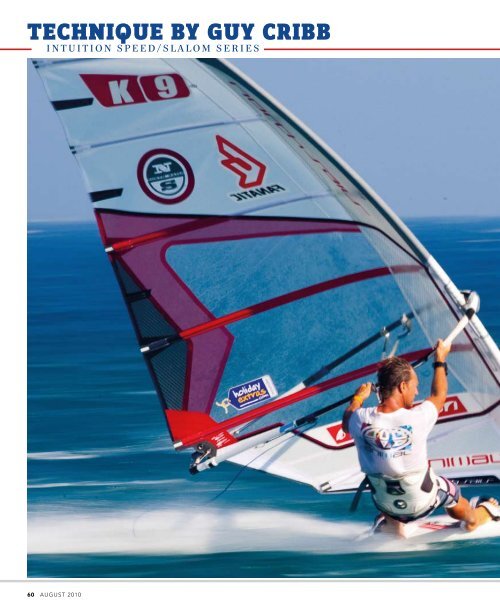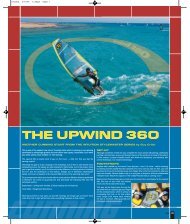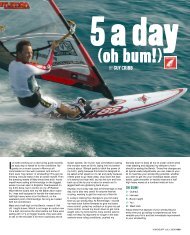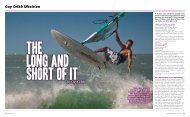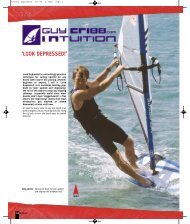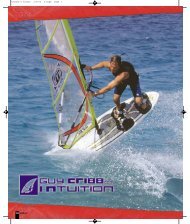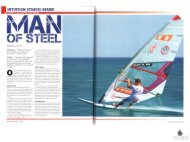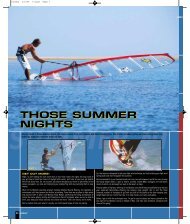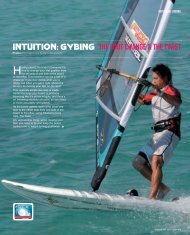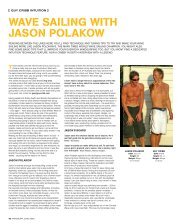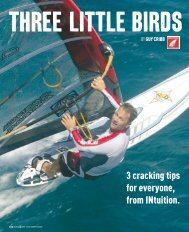Technique by Guy cribb
Technique by Guy cribb
Technique by Guy cribb
You also want an ePaper? Increase the reach of your titles
YUMPU automatically turns print PDFs into web optimized ePapers that Google loves.
<strong>Technique</strong> <strong>by</strong> <strong>Guy</strong> Cribb<br />
I N t u i t i o n S p e e d / S l a l o m S e r i e s<br />
60 AUGUST 2010
WORDS BY: multi times British Champion/ Godfather of INtuition. | photoS <strong>by</strong>: Mark Evans.<br />
Tactics, Tuning<br />
and <strong>Technique</strong>.<br />
October 16-23 in the UK sees Weymouth Speed Week’s third decade of racy<br />
men and women in all kinds of craft from speed-freak windsurfers to geekfreak<br />
sailors in hair-brained designs going head-to-head on the water to<br />
establish who’s the fastest over a 500m track/ about 20-30 seconds of sailing.<br />
Antoine Albeau who holds windsurfing’s speed world record, covered<br />
500m in less than 20 seconds, or 50m in less than two seconds- ie an Olympic<br />
size swimming pool in less than two seconds, every two seconds.<br />
His average speed was 49 knots/ 56.5 mph.<br />
The average windsurfer’s speed is around 20 knots, peaking at 25 if you’re really fast, or around 15-20 if you’re just<br />
blasting back and forth having just got to grips with footsteps. But this does not deter hundreds of windsurfers and<br />
sailors descending on Weymouth hoping to hook into an autumn storm and set their personal best speed record.<br />
Here’s some tips to prepare you for the challenge of speed sailing, whether you’re heading to Speed Week or just<br />
blasting at your local spot.<br />
www.windsurf.co.uk 61
<strong>Technique</strong> <strong>by</strong> <strong>Guy</strong> Cribb<br />
I N t u i t i o n S p e e d / S l a l o m S e r i e s<br />
normal reach<br />
Take a big sail- bigger rigs = more power. You<br />
should find it virtually impossible to sail on a<br />
normal reach with the correct size sail for speed<br />
sailing. With the right size sail you should be able<br />
to sail either upwind or radically downwind, but<br />
across the wind should be a disaster.<br />
Take a small board and fin= less drag<br />
(see tuning section)<br />
Bear off downwind, expect to sail around 135<br />
degrees off the wind for the fastest runs. Yes,<br />
some 45 degrees downwind of your normal<br />
reaching angle. (See image)<br />
Tactics-<br />
The big three tactics for improving your<br />
speeds are- flat water, sailing on a broad reach,<br />
overpowered.<br />
Flat water- if there’s one thing that hinders a<br />
windsurfer’s speed, it’s chop. If you’re speed<br />
sailing at Weymouth in a westerly wind, get as<br />
close to the shoreline as you dare- the flat water<br />
here will allow you to go much faster than the<br />
choppier water further out. How long is your fin?<br />
Allow a few extra centimetres of water depth to<br />
speed sailing broad reach<br />
ensure your safety… If sailing on the sea (or if<br />
the wind is onshore at Weymouth) the key will<br />
be to find the flat water amongst the chop. At<br />
low tide the flattest water is likely to be closest<br />
to the beach, at high tide, it’s probably further<br />
out as there’ll be waves rebounding off the sea<br />
wall/ shore. So if you have to sail in rough water,<br />
search around for the most consistent sea state<br />
and sail in the most regular chop. In this zone, try<br />
to position your board in the grooves between the<br />
waves to find the flattest water.<br />
Balls- take some big balls to bear off the wind,<br />
once you’re going downwind at full tilt, the sail will<br />
be lighter and in more control than it was turning<br />
downwind. Grit your teeth, hold tight and man<br />
up for the first few horrific seconds of bearing off<br />
onto a broad reach.<br />
Be prepared for traffic/ wake/ lulls/ gusts/<br />
carnage= just like in Formula One, don’t expect<br />
to just get one lap in to set your fastest timeyou’ll<br />
need to get familiar with the course, find<br />
the flattest water and get lucky with the gusts.<br />
Every run is different and you can do ten in a row<br />
without the gust you need, so persevere and get<br />
on the track as early as possible to maximise your<br />
potential number of runs.<br />
Weymouth Speed Week tactic- attend the<br />
morning briefing to ensure you know where the<br />
course is, the rules and the course etiquette.<br />
Tuning-<br />
Tuning check list-<br />
Rig- big rig.<br />
Board- narrow board (less drag) narrower than<br />
you would usually use for any given sail size- you<br />
don’t need to worry about coming out of your<br />
gybe planing. I will be using an 80 ish litre board<br />
with 7m, rather than a 100 ish litre board that I’d<br />
normally ride in slalom with such a rig. If you can<br />
borrow a speed board, get it! They’ll give you way<br />
more control. Correct downhaul (which is usually<br />
more than you think) is necessary to have any kind<br />
of control. If you are unable to stay locked in, use<br />
more downhaul. Every centimetre makes a big<br />
difference, and three centimetres is another world.<br />
Note the diagonal wrinkles in my sail? This is called<br />
breaking, every sail should have these wrinklesthey<br />
are the effect caused <strong>by</strong> the<br />
sail twisting.<br />
Outhaul- don’t overdo it- use less than you think<br />
for more power and stability. If you use too much,<br />
these wrinkles become more horizontal around the<br />
boom area- which causes instability.<br />
Harness lines- long harness lines allow you to get<br />
lower whilst keeping the rig upright. I use 30-32” lines<br />
Boom height- lower than<br />
usual- gives you more<br />
control. See mine is 50%<br />
up the cut out whereas<br />
normal boom height<br />
should be 66% ish high<br />
ish.<br />
Mast track- back for<br />
liveliness/ forwards for<br />
control- my guess is you’ll<br />
need more of the latter<br />
if you’re overpowered.<br />
Don’t be scared to put<br />
it forwards into the front<br />
half of the track- over 500<br />
metres the extra control<br />
and directional stability<br />
should pay off better than<br />
a potentially faster peak<br />
speed <strong>by</strong> moving it back.<br />
No two boards are the same so experiment, but if<br />
you’ve taken the right size sail (mahusive) then get<br />
some control with the mast foot position further<br />
forwards than usual.<br />
Batten tension- a massively overlooked feature<br />
of tuning- ensure all battens on the bottom third<br />
of your sail are cranked right on. On many camber<br />
induced sails, crank them on before you rig up, as<br />
once in the cams you can’t get enough tension.<br />
62 AUGUST 2010
The top third of your sail should literally just<br />
have enough tension to take the basic wrinkles<br />
out, and no more, be very gentle with them. The<br />
middle third require careful tuning, namely the<br />
two battens immediately above the boom. Both<br />
will need a lot of tension but the lower one slightly<br />
more than the upper one. Play around with the<br />
tuning here, your objective is to allow the sail to<br />
twist off loads on the leech <strong>by</strong> not over doing the<br />
tension, but to keep enough tension in the front<br />
of the sail for stability and shape/ power. If you are<br />
overpowered, use a little less, if underpowered,<br />
a little more. Note there are no vertical creases<br />
ion my sail around the battens, indicating a full or<br />
correct amount of tension.<br />
Footstraps- tight- if your feet are slipping in over<br />
the 500m, they were too loose in the first place.<br />
Tighter straps in flat water.<br />
Fin- the smaller the fin, the less drag, but don’t go<br />
crazy- for the average windsurfer at Speed Week<br />
expect to use roughly these fin sizes- 7m with 34cm,<br />
6m with 30cm, 5m with 26cm. Speed freaks and pro’s<br />
will probably go a bit smaller than this guideline<br />
(which FYI is already approx 2- 4cm smaller than<br />
standard slalom fin sizing.) Fin size is also relevant<br />
to board width, and as you are on narrower boards,<br />
use smaller fins for the usual sail size. Ensure fins<br />
are smooth- and if you scuff them, rub them down<br />
immediately with a stone or sandpaper.<br />
Flaps- tuck your flaps in, at 40mph the windage<br />
on you will be relevant. Be smooth!<br />
<strong>Guy</strong> Cribb INtuition<br />
13 x British Windsurfing Champion<br />
World’s leading windsurfing coach.<br />
<strong>Guy</strong> Cribb runs the legendary INtuition coaching<br />
courses all over the world for windsurfers<br />
learning how to use footsteps, waterstart or<br />
carve gybe in Greece and Egypt, right through<br />
first time into waves and forward looping in<br />
Morocco, UK and Ireland, to advanced wave<br />
clinics in Hawaii and Mexico. All courses only<br />
go to the world’s very best venues at exactly<br />
the right time of year for perfect conditions,<br />
exclusively using the very best equipment rental<br />
centres and staying in the best accommodation.<br />
For the fastest way to develop your windsurfing,<br />
try and get a place on one of these trips!<br />
His technique DVD ‘INtuition Gybing and Core<br />
Skills’ is the most acclaimed instructional movie<br />
ever produced in windsurfing- Google it!<br />
For all things windsurfing, please email<br />
guy@guy<strong>cribb</strong>.com<br />
INtuition, riding the world <strong>by</strong> storm.<br />
www.guy<strong>cribb</strong>.com<br />
Copyright <strong>Guy</strong> Cribb 2010<br />
<strong>Technique</strong>-<br />
Sailing overpowered requires great tuning, but<br />
also great control.<br />
Having helped a gazzillion guests to improve their<br />
technique and speeds, I’ve monitored what tips<br />
make the biggest difference. I would say they are<br />
in this order for intermediates- flatter water, more<br />
power, sailing on a broader reach- these three<br />
basic tactics all radically improve speeds. But at<br />
Weymouth, everyone will be using those tactics,<br />
so moving into more advanced windsurfing,<br />
the tips that made the biggest difference to<br />
increasing your speed are, in reverse order-<br />
3rd place- INtuition’s Hip to be square (H2B2)- the<br />
action of twisting your hips to become parallel<br />
to the centre line of your board, and there<strong>by</strong><br />
actively ‘sheeting in’ with your harness. Achieved<br />
<strong>by</strong> extending your back leg/ pushing your ass out.<br />
On a reach, this can boost your performance <strong>by</strong> as<br />
much as 3-4 knots!<br />
2nd place- letting the mast go away from you <strong>by</strong><br />
extending your front arm. Your front arm is rather<br />
like a handbrake- if you pull it in, the sail sheets<br />
out and you slow down. If you let the hand brake<br />
off, the mast goes further away from you and<br />
the sail sheets in, not just increasing power, but<br />
radically improving the angle of your rig. The rig<br />
should be slicing like a knife towards the direction<br />
you are heading for the most efficient sailing.<br />
Unfortunately most windsurfers rigs are a little<br />
sideways <strong>by</strong> having their lines too far forwards<br />
or bending their back leg too much. One of the<br />
best tips for accelerating is also one of the best<br />
tips to help slice the rig for more speed on a<br />
broad reach- move your front hand further back.<br />
Bringing it back towards the front harness line will<br />
let the mast go further away from you.<br />
1st place goes to INtuition’s Man Of Steel. Of<br />
all the tips, the skill that makes you sail faster is<br />
becoming stiffer. Why spend hundreds on 100%<br />
carbon masts and booms if you’re made of<br />
rubber. Toughen up, grit your teeth, grip with your<br />
feet, clench your butt and turn your body into a<br />
man of steel, tensing every muscle to become<br />
rock solid for efficiency. When a gust hits you, let<br />
the sail twist off, not you!<br />
Summary<br />
Weymouth Speed Week- October 16-23<br />
www.speedsailing.com<br />
Technology takes over during this year’s<br />
Weymouth Speed Week as everyone’s speeds<br />
will be registered using the GT31 GPS unit- the<br />
windsurfing industry standard speed freak gizmo.<br />
Speedsailing.com has all the info online about<br />
purchasing or renting them, and setting them up<br />
correctly to compete. During the week, riders data<br />
will go online for the world to see.<br />
If anyone wants some speed tips and tuning<br />
advice during the week, I will be there for the<br />
windiest day only (based on a forecast) please<br />
email me if you’d like to join an impromptu<br />
coaching session with guaranteed wind, to boost<br />
your speeds, or your money back :-)<br />
Amongst the famous names on the beach will<br />
be our former King of Windsurfing, Senor Bjorn<br />
Dunkerbeck! Worth coming down just to see the<br />
legend in action!<br />
For the enthusiastic windsurfer, rather than the<br />
dedicated speedster, there’s an option to enter<br />
Speed Week for just two days- that’s what I’ve<br />
done as I’ll only go on a forecast for the very<br />
windiest day. Although Nick Povey, Weymouth<br />
Speed Week organiser, assured me “It will be<br />
windy - the law of averages says so!”<br />
Hope to see you there!<br />
www.windsurf.co.uk 63


